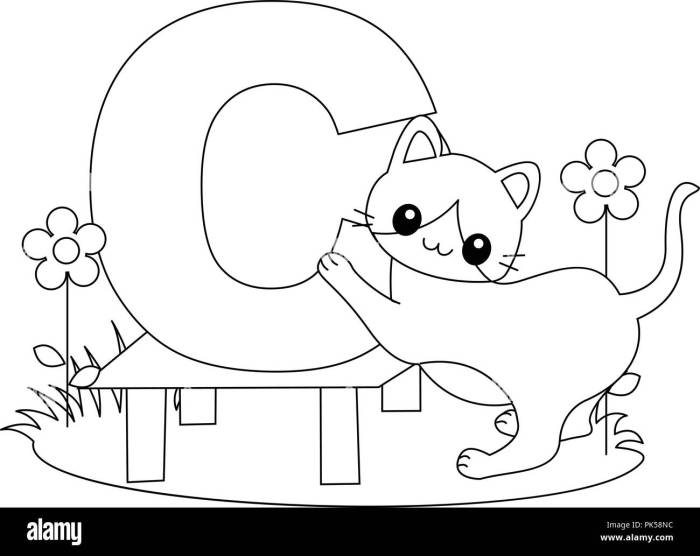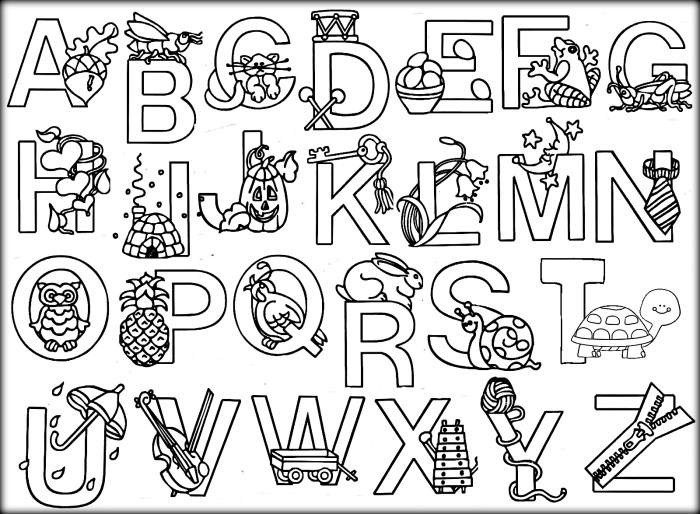Educational Value & Content: Coloring Pages Alphabet Animals

Coloring pages alphabet animals – These alphabet animal coloring pages aren’t just a fun activity; they’re a sneaky way to boost a youngin’s learning. We can pack in loads more than just the ABCs, making them a proper educational tool, not just a bit of kiddy fluff. Think of it as covert learning – they’re having a blast coloring, and boom! Their brain’s getting a workout.Clever design can turn these pages into mini-learning powerhouses.
By focusing on details like intricate shapes and varying line thicknesses, we can subtly encourage the development of crucial fine motor skills. This isn’t just about holding a crayon; it’s about precision, hand-eye coordination, and the development of those tiny muscles needed for writing and other everyday tasks. Plus, let’s be honest, a kid who can master a particularly fiddly zebra stripe is gonna be chuffed.
Animal Facts and Vocabulary Expansion
Adding simple animal facts to each page is a total game-changer. Instead of just “A is for Alligator,” we could have “A is for Alligator – they have powerful jaws and sharp teeth!” This adds a layer of factual knowledge without overwhelming the child. We could even introduce simple vocabulary related to each animal – habitat, diet, characteristics.
Imagine a coloring page of a lion with a small box next to it containing the words “mane,” “claw,” and “roar,” encouraging the child to learn new words in context.
Fine Motor Skill Development Through Design, Coloring pages alphabet animals
The design of the coloring pages themselves plays a huge role. Varying line thickness, intricate patterns within the animal shapes, and small details like whiskers or scales all challenge the child’s fine motor skills. For example, a coloring page featuring a butterfly with delicate wing patterns will require more precise coloring than a simple Artikel of a hippo.
Adding elements like dotted lines for the child to follow, or sections requiring shading, further enhances this aspect. Think about the difference between coloring a simple circle for an ‘O’ compared to coloring an octopus with eight detailed tentacles and suction cups.
Enhancing Learning with Complementary Activities
Beyond coloring, we can create supplementary activities to deepen the learning experience. This could include simple matching games (matching animal pictures to their names), short animal-themed quizzes, or even creating mini-animal fact files based on the information presented on the coloring pages. A simple activity could involve finding pictures of the animals in books or online, further cementing their knowledge.
Coloring pages featuring alphabet animals are a fun way to learn letters while sparking creativity. If you’re looking for even more adorable options, check out these cute animal coloring pages ; they’re perfect for expanding your collection beyond just the alphabet. Then, you can combine the two sets for a really diverse and engaging coloring experience with plenty of cute critters.
Another option could be creating a small animal habitat diorama using recycled materials, relating it to the animal’s natural habitat featured in the coloring page.
Diverse Animal Types for Broader Appeal
To keep things interesting and cater to different preferences, we should include a wide variety of animals. Farm animals, jungle creatures, ocean dwellers – the more variety, the more engagement. Think cute sheep alongside ferocious tigers, playful dolphins alongside grumpy-looking hippos. This broader range keeps things fresh and prevents the pages from becoming repetitive. This diversity also opens up opportunities to introduce geographical concepts and different ecosystems in a fun and engaging way.
Learning Objectives for Children
The aim is to achieve several learning objectives through these coloring pages. These include: developing fine motor skills, expanding vocabulary, improving knowledge of the alphabet, learning basic animal facts, and enhancing color recognition and hand-eye coordination. The pages should contribute to the child’s overall cognitive development in a fun and playful manner. The goal isn’t to turn them into mini-zoologists, but to plant the seeds of curiosity and learning.
Production & Distribution

Getting these alphabet animal coloring pages from digital sketch to printed masterpiece, and then into the hands (or paws!) of eager little artists, needs a proper game plan. We’re talking slick production and a distribution strategy that’s smoother than a freshly-laid tarmac.Creating high-resolution digital versions ready for printing involves a few key steps. First, you need a top-notch graphics program like Adobe Illustrator or Affinity Designer.
These programs allow for creating vector graphics, meaning the images can be scaled to any size without losing quality – crucial for printing large formats or high-resolution PDFs. Each illustration should be created at a minimum resolution of 300 DPI (dots per inch) for crisp, clear prints. Colour palettes should be vibrant but printer-friendly, avoiding overly saturated colours that might look muddy when printed.
Finally, each design needs to be carefully checked for any errors or inconsistencies before moving on.
Printing and Distribution Methods
Printing and distribution can happen in several ways, each with its own vibe. Print-on-demand services like Printful or Gooten are ideal for smaller-scale operations, handling printing and shipping automatically once an order is placed. This eliminates the need for upfront inventory investment. Alternatively, you could opt for a bulk print run with a local print shop for a potentially lower per-unit cost if you’re confident in your sales projections.
Digital distribution is also key – offering downloadable PDFs from your website or Etsy shop provides instant gratification and broad reach.
Creating a Printable PDF
Creating a printable PDF optimized for various printer settings is crucial. Use PDF creation software that allows you to embed colour profiles (like sRGB or Adobe RGB) to ensure accurate colour reproduction across different printers. The PDF should be designed with bleed (extra space beyond the trim line) to avoid white edges when printed. Consider offering different PDF versions – one with individual pages and another with multiple pages per sheet for economical printing.
Clear instructions on printing settings (paper size, orientation, etc.) should also be included within the PDF itself.
Online Platforms for Selling or Sharing
A few solid online platforms for selling or sharing your coloring pages include Etsy, which has a massive crafting community; Creative Market, a platform focused on digital assets; and your own website, giving you complete control over branding and pricing. Free platforms like Teachers Pay Teachers could also be considered if you’re focusing on an educational audience. Each platform has its own advantages and disadvantages regarding fees, marketing tools, and audience reach.
Marketing and Promotion Strategies
Marketing your coloring pages requires a multi-pronged approach. Social media marketing (Instagram, Pinterest, Facebook) is crucial, showcasing visually appealing images of the finished coloring pages and potentially featuring user-generated content. Running targeted ads on these platforms can significantly boost visibility. Collaborating with parenting bloggers or influencers can also expand your reach to a relevant audience. Offering discounts or bundles can incentivize purchases.
Running contests or giveaways can also generate buzz and engagement. Finally, optimization of your website or online store will help potential customers find your product through search engines.
FAQ
What age group are these coloring pages most suitable for?
These coloring pages are primarily designed for preschool and early elementary school children (ages 3-7), but can be enjoyed by older children as well.
Are the coloring pages available in different formats?
Yes, they can be offered in both printable PDF format and potentially as digital downloads or even as part of a subscription service.
How can I incorporate these coloring pages into a classroom setting?
They can be used for alphabet lessons, animal unit studies, quiet time activities, or as rewards for good behavior. Incorporate additional activities like animal fact discussions or vocabulary building exercises.
What kind of paper is best for printing these coloring pages?
Heavier weight paper (at least 80lb or 120gsm) is recommended to prevent bleed-through and to make the finished product more durable.
